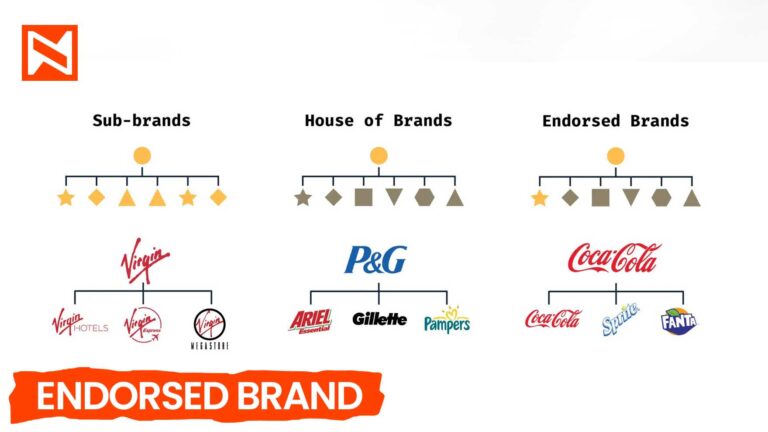Creating a strong brand identity that resonates with consumers is essential for any business that wants to succeed in today’s competitive market. One branding strategy that has gained popularity in recent years is endorsed branding. With endorsed branding, a parent company maintains an association with different product or service brands while allowing them to have their own distinct identity. This approach has proven to be an effective way for companies to leverage the reputation and trust established by their parent brand, while still appealing to specific audiences.
In this blog post, we will take a closer look at endorsed branding and explore its benefits, including its ability to enhance customer loyalty, increase sales, and create a more powerful brand identity. We’ll also discuss how to effectively implement an endorsed branding strategy, including tips for choosing the right product or service brands to endorse, and the importance of maintaining consistency across all brand messaging. By the end of this post, you’ll have a deeper understanding of how endorsed branding can help you build a more successful brand and increase customer trust and loyalty. So, let’s dive into the world of endorsed branding together!
Brand Architecture
To properly grasp the environment in which an endorsed brand exists, let’s begin with a brief discussion of brand architecture.
An organizational brand strategy known as brand architecture is used to organize a portfolio of goods, services, entities, or sub-brands.
Whether or not these sub-brands are divided into separate entities, the brand architecture makes a clear distinction between basic product names and segmented market targeting, positioning, and message. Continue reading to further understand the concept.
What is an Endorsed Brand
A brand architecture structure called endorsed branding consists of clearly distinct product or service brands that are positioned apart from their parent brand (also known as an endorser brand).
Despite the evident differences between these sub-brands, they all continue to be associated with the parent brand of the endorser via visual cues (i.e. the parent brand mark).
This architectural approach benefits from independent positioning, visual identity, personality, and message while using the parent brand’s reputation and brand value.
In other words, an endorsed brand benefits from both worlds.
What Is An Endorsed Brand Identity?
An Endorsed brand’s visual brand identity is known as its endorsed brand identity.
Without restricting any of the visual identity aspects, the brand identity style and look are often noticeably unique from those of its parent brand and include:
Identity / Brand Mark
Typography
The color scheme of the image
Iconography
Illustrations and graphics
Why Use an Endorsed Brand Strategy?
There are methods for navigating various issues. There are brand strategies to deal with various branding issues.
Businesses with various brands in their portfolios must select how to organize those brands for internal and external communication.
The approved model falls somewhere in the middle of all brand architecture strategies, which might range from dependency to independence in nature.
Examples of Endorsed Brands
Endorsed brands are more prevalent than you may think, even though most consumers probably couldn’t distinguish between an endorsed brand and an entirely independent brand.
Marriott

Marriott effectively maintains a degree of independence and generates a different character for each of its offers by generating separate logos for each brand.
Consider Marriott’s brand portfolio, which includes Marriott Hotels & Resorts, Sheraton, Westin, and Courtyard. Each of these brands has its own logo that is prominently displayed to show its own personality and brand traits. Nonetheless, the master brand “Marriott” is incorporated into the brand logos, which are often positioned below, confirming the link and endorsement to the overall Marriott brand.
This strategic strategy allows Marriott to capitalize on the master brand’s familiarity and trust while also enabling consumers to discern between the many brands and their specialized services. Marriott efficiently conveys the varied value propositions of its portfolio by striking a careful balance between utilizing the familiarity of the master brand and building individual identities for each brand.
The presence of the master brand underneath the brand logos acts as a visual indication to clients, indicating that these brands are supported and backed by the well-known Marriott brand. This endorsement not only promotes confidence and dependability but also encourages cross-promotion and consumer loyalty throughout the whole brand ecosystem.
Marriott demonstrates its ability to use the power of its master brand while retaining brand distinctiveness and responding to the individual tastes and demands of clients in diverse market groups by using the Endorsed Brands strategy. This method maximizes the reputation of the master brand while allowing for flexibility and modification within the brands, resulting in a complete and unified brand architectural plan.
Ralph Lauren

Ralph Lauren is another good example of the Endorsed Brands model. Under the Ralph Lauren brand architecture, we can see the synergy between the master brand and its brands such as Polo Ralph Lauren, Ralph Lauren Home, The Polo Bar, and Ralph’s.
Each brand within the Ralph Lauren portfolio maintains its own unique identity while benefiting from the endorsement and visibility of the master brand. For instance, Polo Ralph Lauren is recognized as a distinct brand that focuses on clothing and accessories, known for its iconic polo player logo. Ralph Lauren Home caters to the home furnishings and decor market, showcasing a range of products with a sophisticated aesthetic.
Furthermore, Ralph Lauren extends its brand presence beyond products and into experiences with The Polo Bar, a renowned restaurant that reflects the elegance and style associated with the Ralph Lauren brand. Additionally, Ralph’s is a brand that encompasses a collection of high-end restaurants, providing a culinary experience that aligns with the Ralph Lauren brand’s values and image.
The Endorsed Brands model allows Ralph Lauren to leverage the brand equity and recognition of the master brand, establishing a consistent level of quality, style, and luxury across its brands. While each brand has its own distinct logo and positioning, the endorsement of the Ralph Lauren master brand serves to enhance its credibility and appeal in the market.
Kellogg’s

Kellogg’s brand architecture is another excellent example of the Endorsed Brands approach. Similar to Marriott, Kellogg’s supports its various brands by incorporating the company logo, which is positioned above the brand logos.
In the case of Kellogg’s, the master brand logo is not as prominently displayed compared to the brand logos. It is somewhat more concealed, with the purpose of providing a subtle endorsement and leveraging positive equity for the brands. Kellogg’s creates new and distinct brands, each with its own unique identity and visual representation.
The Endorsed Brands approach, as demonstrated by Kellogg’s, allows for the creation of new and unique brands while leveraging the positive equity of the master brand. It offers flexibility and customization but also requires careful brand management to maintain consistency and ensure the success of both the master brand and its brands.
Virgin Group

Virgin is a prime example of the Endorsed Brands model, with a diverse portfolio of brands that benefit from the visibility and support of the master brand. Virgin’s brand architecture includes brands like Virgin Active, Virgin Radio or Virgin Media, Virgin Books, Virgin Casino, and Virgin Records.
Each of these brands operates in different industries and markets, but they all carry the endorsement and connection to the overarching Virgin brand. Virgin Active focuses on fitness and health clubs, while Virgin Radio or Virgin Media ventures into the broadcasting and media sector. Virgin Books caters to the publishing industry, Virgin Casino offers online gambling and gaming services, and Virgin Records is a renowned record label.
The Endorsed Brands approach allows Virgin to establish a consistent brand identity across its diverse range of businesses, while still allowing each brand to have its own unique visual identity and positioning. The master brand, Virgin, serves as a symbol of innovation, quality, and customer-centricity, providing a sense of familiarity and trust to consumers across different industries.
Nestlé Brand Design
One of the most recognizable endorsed brands in the world is Nestlé.
In reality, Nestle is a House Of Brands brand as well as an endorser.
In addition to endorsing many of its brands, it also has a portfolio of products that are giants in their own right, such as Nescafe, Nespresso, San Pellegrino, Cheerios, Chef, and Nestea Perrier.
Nestle is the best illustration of how to implement the endorsed brand strategy.
The parent brand is the market leader with a strong reputation and brand equity, and each of its endorsed brands has become a major player on their own in their respective markets.
The following are Nestle-endorsed products: Milo, Smarties, KitKat, Nesquick, Pure Life Water, Coffee-Mate,
Milkybar.
Disadvantages and Benefits of Endorsed Brands
Let’s examine the advantages and disadvantages of the endorsed brand approach in more detail to better understand why a parent brand might decide to become an endorser brand.
Benefits of Endorsed Brand Design
Endorsed Brands resemble trust fund children. They now have an advantage in the world and may enjoy their freedom.
The following are a few of the main benefits:
- They make use of the parent Brand’s reputation and brand value.
- They don’t have to start from scratch to build brand recognition.
- Growing sister’s reputation and success have repercussions.
- More protection provided by a reputable parent brand
- In collaboration with the parent brand, improved marketing efficiency and lower costs were achieved.
Disadvantages of Endorsed Brands
While Endorsed Brands do have a clear benefit, there are hazards to be aware of that other brands don’t.
- Both the parent brand and sibling brands have an impact on the reputation of each other.
- Even if the endorsed brand is independent, it still has to adhere to the parent brand’s values and principles.
- Delayed market reactions might result from a complex line of command.
Endorsed Branding vs. Subbranding
Endorsed Branding:
- Parent brand endorses or associates itself with different product or service brands
- Individual brands maintain their own distinct identities
- Allows flexibility for individual products or services to target specific audiences
- Leverages the reputation and trust established by the parent brand
- Endorsed brands have more autonomy in messaging, positioning, and target audience
- Parent brand is usually less visible than individual product or service brands
Subbranding:
- Creating a new brand under the parent brand, typically for a specific product or service
- Subbrand is associated with the parent brand and often features a similar name or logo
- Subbrand is often more closely aligned with the parent brand in terms of branding decisions
- Parent brand is often more visible, as the subbrand is closely associated with it.
Tips for Endoursed Branding
Choose the right parent brand:
It’s important to choose a parent brand that has a strong reputation and is well-known in the market. This will help to leverage the trust and reputation of the parent brand to promote the endorsed product or service brand.
Maintain a clear brand identity:
While the endorsed brand should maintain its own distinct identity, it’s important to ensure that it’s still closely associated with the parent brand. This can be achieved through consistent branding elements such as logos, colors, and messaging.
Clearly communicate the endorsement:
Consumers need to know that the endorsed brand is associated with the parent brand. Make sure to clearly communicate the endorsement in marketing materials, on product packaging, and on the website.
Foster collaboration between parent and endorsed brands:
Collaboration between the parent and endorsed brands can help to ensure that the messaging, positioning, and target audience are aligned. This can help to maintain consistency and trust in the brand.
Allow flexibility:
Endorsed branding allows for individual product or service brands to target specific audiences and maintain their own distinct identities. It’s important to allow for flexibility in messaging, positioning, and target audience, while still maintaining a clear association with the parent brand.
Final Words on Endorsed Brands
Endorsed branding is a powerful branding strategy that allows businesses to maintain a separate identity for their product or service brand while still benefiting from the trust and reputation of the parent brand. By following the tips outlined above, businesses can effectively implement an endorsed branding strategy and enjoy increased consumer confidence, brand loyalty, and sales. With the right parent brand, clear brand identity, and effective communication, businesses can successfully leverage the power of endorsed branding to achieve their marketing and sales goals.
FAQs on Endorsed Brands.
How does endorsed branding differ from sub-branding?
Endorsed branding involves maintaining a separate identity for the endorsed brand while also maintaining a clear association with the parent brand. Sub-branding, on the other hand, involves creating a new brand identity under the umbrella of the parent brand.
What are the benefits of using an endorsed branding strategy?
Endorsed branding allows for individual product or service brands to target specific audiences and maintain their own distinct identities, while still benefiting from the trust and reputation of the parent brand. This can lead to increased consumer confidence, brand loyalty, and sales.
How can a business effectively implement an endorsed branding strategy?
It’s important to choose the right parent brand, maintain a clear brand identity, communicate the endorsement clearly, foster collaboration between parent and endorsed brands, and allow for flexibility in messaging, positioning, and target audience.
What are some examples of endorsed brands?
Some examples of endorsed brands include Nestle Toll House, Hilton Hotels, Samsung Galaxy, Dove Men+Care, and Ford Mustang.
Can an endorsed brand have its own unique identity?
Yes, an endorsed brand can have its own unique identity while still maintaining a clear association with the parent brand.
How can an endorsed brand benefit the parent brand?
An endorsed brand can help to increase brand awareness and loyalty for the parent brand, as well as expand its reach into new markets and audiences.






![How To Become A Brand Strategist [Easy Guide]](https://naumandigital.com/wp-content/uploads/2023/10/pexels-andrea-piacquadio-3771098-600x400.jpg)

![Brand Designer vs Brand Strategist [What’s the difference]](https://naumandigital.com/wp-content/uploads/2023/02/18-600x400.jpg)
![What is Sustainability Branding [Complete Guide]](https://naumandigital.com/wp-content/uploads/2023/10/WhatsApp-Image-2023-10-18-at-3.58.50-PM-600x400.jpeg)